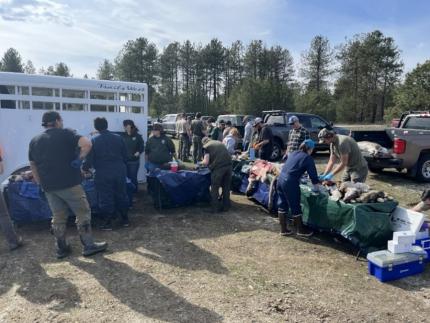
Wildlife Program report: Mar. 16-31, 2024
Managing Wildlife Populations
Necropsy Training: Biologists Lowe and Brinkman attended a necropsy training conducted by Washington Department of Fish and Wildlife (WDFW) Veterinarians Drs. Mansfield and Haman, and Pathologist Dr. Oliveira from the Washington Animal Disease Diagnostic Lab (WADDL) at Washington State University (WSU). Staff members from several eastside districts and programs attended the class, which included classroom instruction and field necropsies on a variety of species. During the training, Dr. Oliveira performed a necropsy on a bighorn ewe that was collected last week from the Lincoln Cliffs herd.

Fairchild Airforce Base: Biologist Lowe worked with Habitat Biologist Westerman to review and provide comments for the 2024-2028 Draft Integrated Natural Resource Management Plan (INRMP) for Fairchild Air Force Base in Spokane County.
Providing Recreation Opportunities
Eloika Lake Parking Stops: Access Manager Dziekan and Natural Resource Technician Brant traveled to Eloika Lake to replace parking stops that have been crumbling. The first step was to remove the old blocks. Dziekan and Brant used pry-bars to lift the blocks that were in place, and a sledgehammer to loosen up the rebar anchors. They prepped and leveled the site. Then they carefully removed the new parking stops from the dump trailer and placed them where the old stops were originally located. The old rebar was salvaged and was driven into the ground where the old anchors were. The old parking stops were turned into gravel and spread in the parking area on site.
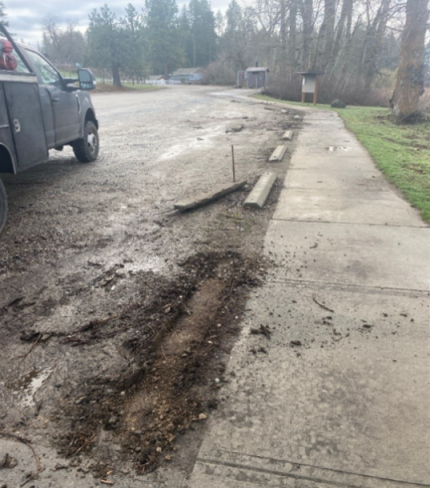
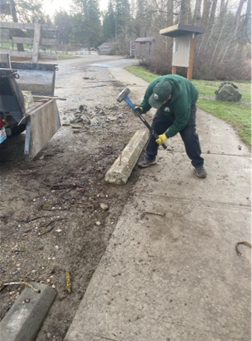
Wildlife Area Maintenance: Sherman Creek Wildlife Area Assistant Manager Palmer used a mini excavator to continue cleaning up roads and trails on Bisbee Mountain, at Sherman Creek Wildlife Area. He also started cleaning up the exposed portion of the irrigation system coming off Sherman Creek. He removed leaves and silt and cleaned out the trash rack to ensure the water flows smoothly. This work is in preparation for turning on the seasonal irrigation system and gate opening on April 1.
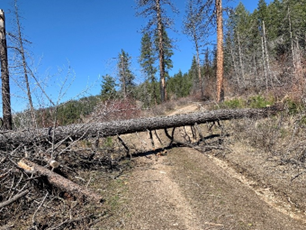
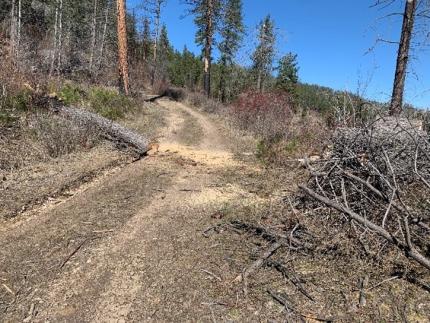
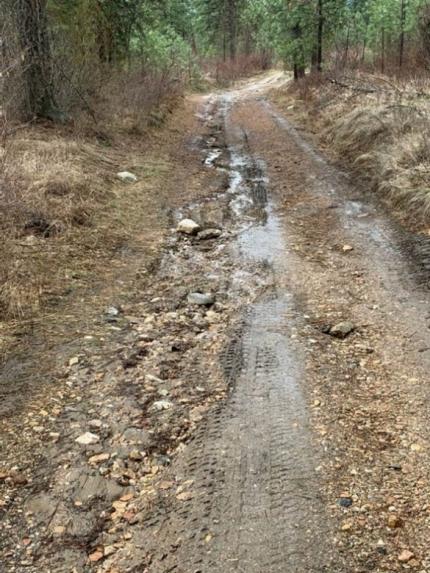
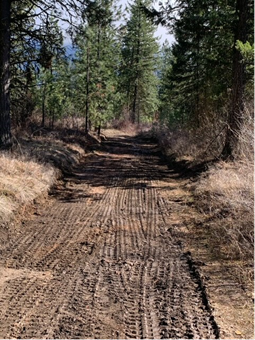
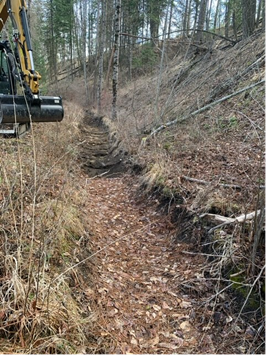
Conserving Natural Landscapes
Volunteer Opportunities: Private Lands Biologist Nizer coordinated and setup four volunteer events for registered Whitman County Washington Department of Fish and Wildlife volunteers. Nizer led a crew of eight volunteers to plant 1,700 plants at designated locations on private lands enrolled in the Private Lands Access Program.
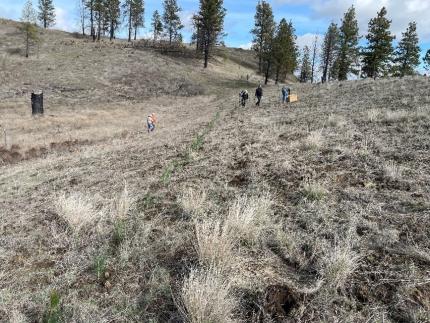
Spring Weed Control: Wildlife Area Manager Dice sprayed food plot fields at Joseph Creek in preparation for spring food plot planting. Assistant Wildlife Area Manager Woodall started spraying parking lots with a pre-emergent herbicide that will keep them clean and looking good. This work will continue next week. Natural Resource Technicians Meisner and Hammons spent the whole week spraying emerging Scotch thistles in upland areas at the Halsey Unit.
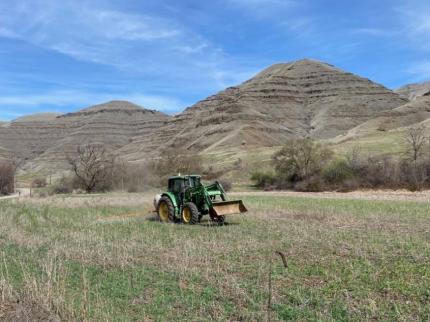
Noxious Weed Control: Wildlife Area Manager Dingman listened in on the Rocky Mountain Elk Foundation Project Advisory Committee meeting where they reviewed grant applications and answered questions pertaining to her noxious weed control grant application. The project ranked second on their list to be funded so once the official letter is received the project to spray yellow star thistle in upper Tumalum Creek can move forward.
Conducting Business Operations and Policy
General Facilities and Equipment Maintenance and Repairs: Dziekan and Brant inspected their shop and vehicle first aid supplies and ordered more items to have fully stocked kits on hand, both in the shop and for the field.
Asotin Creek Wildlife Area, Smoothing Iron Well Pit: Meisner and Hammons replaced a crumbling concrete well ring near the Smoothing Iron house. The old ring was failing, and it was not safe. They also installed a new concrete top with a manhole making access to well and pump equipment easier.
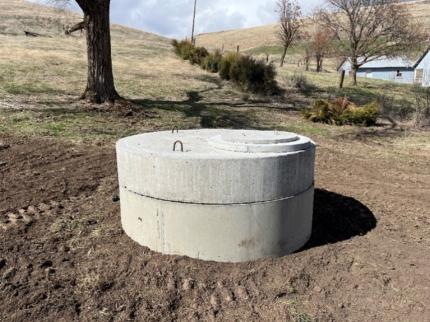
Trainings: Natural Resource Technician Moberg attended the “How to Submit a Safety and Security Incident Report” online training. Moberg updated her First Aid/CPR Certification in Spokane. Additionally, Moberg studied Washington pesticide laws and related regulations for her upcoming pesticide certification test.
Managing Wildlife Populations
Sinlahekin Beavers: Manager Wehmeyer was out inspecting campgrounds to see what spring maintenance needed to be done, when he came across an area that looked like someone had been falling trees. On further inspection the notorious sport faller was a beaver, that had been hard at work building its dam.
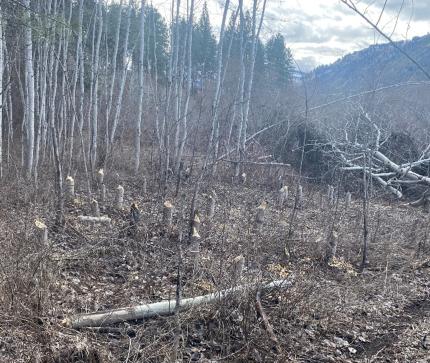
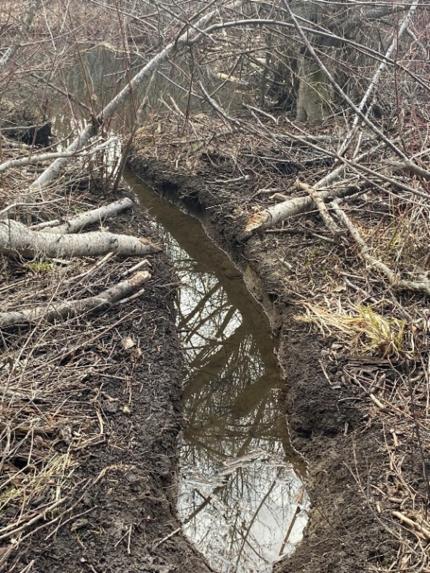
Sage Grouse Surveys: Biologist Morris continued sage grouse searches. He will be searching grids in Grant and Douglas counties without known sage grouse leks. He is hoping to find birds or new leks.
Ground Squirrels: Biologists Clements and Dougherty worked with Columbia Basin Wildlife Area staff members and borrowed equipment from the region Private Lands team to begin habitat enhancement work for Washington ground squirrels in the Seep Lakes Unit of the Columbia Basin Wildlife Area.
Northern Leopard Frogs: The District 5 frog team (Biologists Clements, Dougherty, Nason, Turnock, and Technicians Hara and Force) has been working to locate northern leopard frog egg masses to assist with species recovery efforts, to date there have been nine egg masses located. Eggs will be collected from each mass (which represents a single female breeding effort). The eggs will be transported to either a partner zoo or to the translocation site. The frog team will continue monitoring northern leopard frog breeding throughout the occupied areas. Additionally, the frog team will be adding two technicians in the coming weeks to further increase staff member capacity.
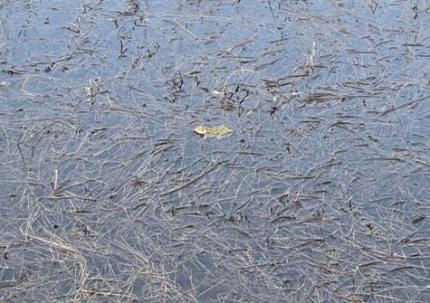
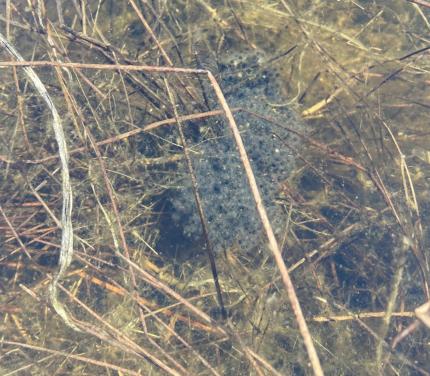
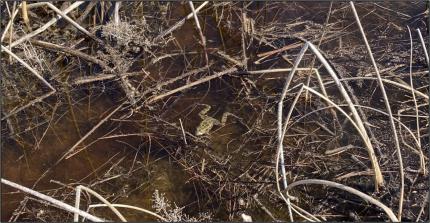
Waterfowl: In early March, Biologist Clements along with some additional Washington Department of Fish and Wildlife staff members participated in the U.S. Fish and Wildlife Service Pacific Flyway Wingbee Workshop in Redding, California. Hunters throughout the Pacific Flyway are selected and requested to submit the wings of their harvested geese and ducks throughout the season. Then biologists come together to determine species, sex and age of each wing. At this year’s workshop, biologists inspected 17,000 wings.
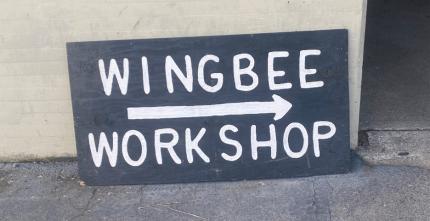
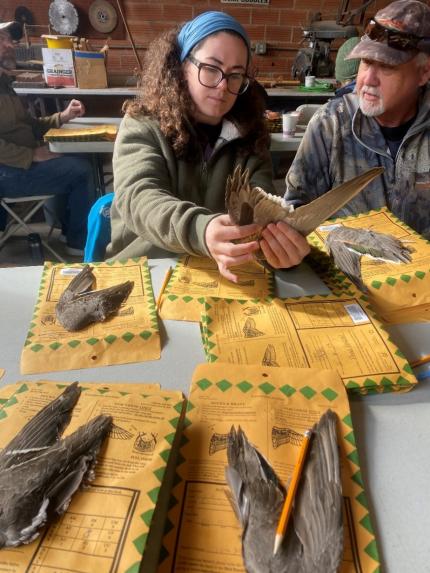
Greater Sage-grouse: Biologists across Douglas County continue to monitor known greater sage-grouse lek sites and search for new ones. A couple new leks have already been identified! Sage-grouse numbers recorded so far this spring are higher than they have been since the Pearl Hill fire, which is encouraging to see, because this species is classified as endangered by the State of Washington, and has been experiencing a dramatic population decline for many years now. For more information on greater sage-grouse in Washington, visit the WDFW website.
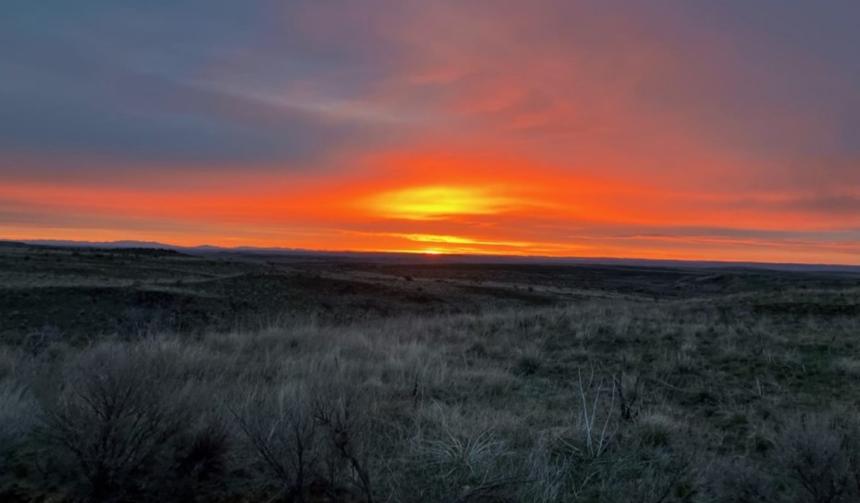
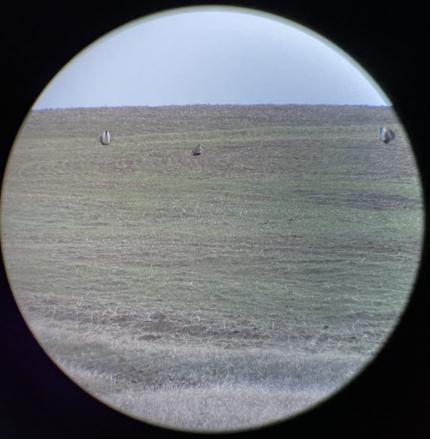
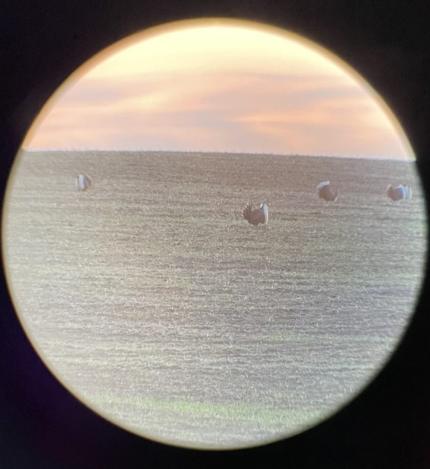
More recently, Biologist Clements assisted staff members from Alaska Department of Fish and Game with Canada goose captures. The capture efforts were primarily focused on lesser and Tavener’s Canada geese to better understand harvest and migration for these sub-species.
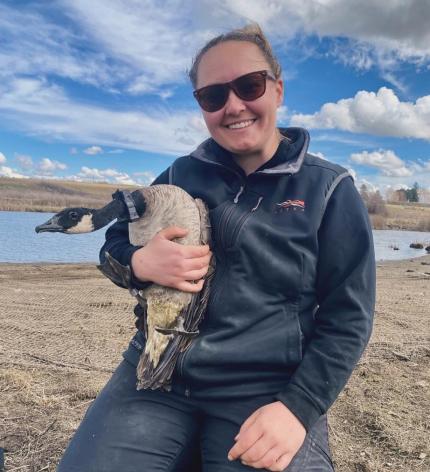
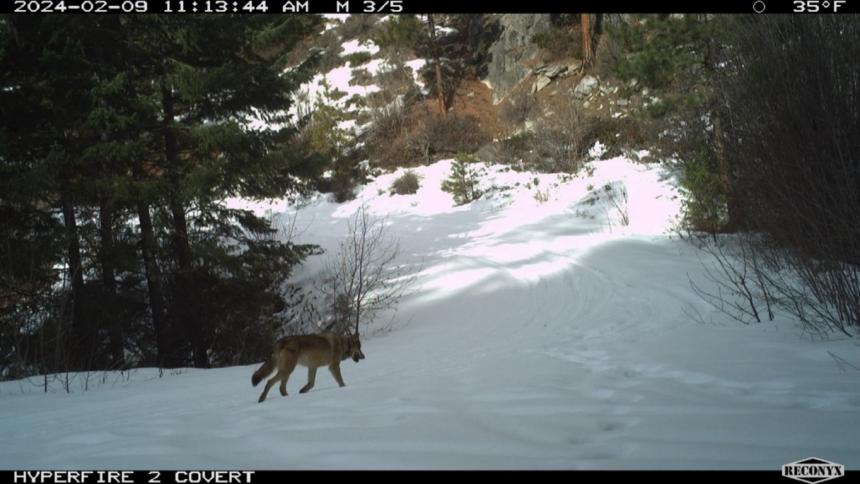
Wolf Cameras: Biologists Jeffreys, Eilers, and Morris picked up three remote trail cameras north of Lake Chelan that were used to survey the area for wolf occupancy. A female collared wolf from the Navarre pack was photographed. She was collared a couple years ago, but the collar malfunctioned and is no longer sending information. Other wildlife captured on camera included mule deer, bobcat, and coyote.
Spring Mule Deer Surveys: Biologists Fitkin and Heinlen started spring mule deer surveys to gather data on fawn recruitment. Early returns suggest over-winter fawn mortality was low, which is not surprising given the generally very mild winter conditions.
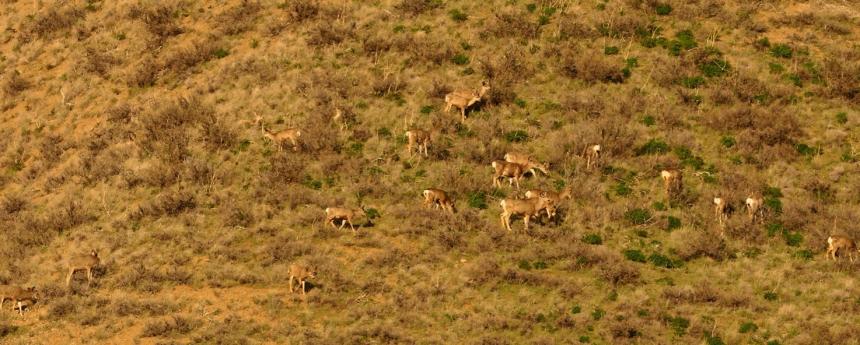

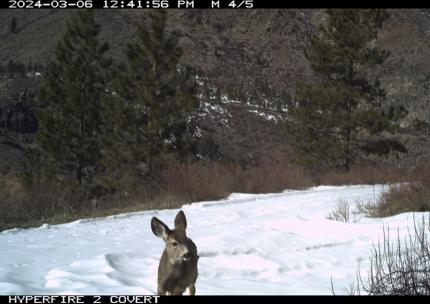
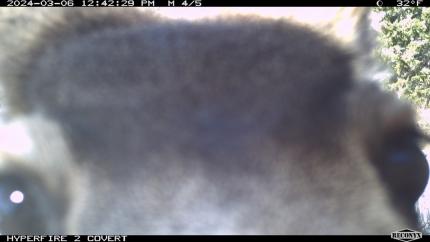
Mule Deer: Biologists Jeffreys and Eilers picked up 15 remote trail cameras on game trails near Blewett Pass. These cameras were used to capture images of the Wenatchee Mountains mule deer herd from October 2023 through December 2023 when they were undertaking their annual eastward migration to lower elevation winter range. Biologists will soon analyze all images collected to determine age and sex of photographed deer and use this information to generate fawn to doe and buck to doe ratios for the herd. Biologists will then compare these ratios with those obtained from aerial surveys that took place in December 2023 to determine whether remote camera placement could be a viable method to assess mule deer herd composition moving forward.


Managing Wildlife Populations
Sharp-tailed Grouse Translocation: This month, fifteen male and fifteen female sharp-tailed grouse were trapped in British Columbia and relocated to the Sagebrush Flat Wildlife Area. Wildlife area managers and staff members transported the birds from the Canadian border and transferred them to release boxes in the wildlife area and released them from there. Satellite tracking is being used to follow the movements of these birds, and staff members have enjoyed watching where they choose to spend their time. This translocation required cooperation and involved working with the sharp-tailed grouse translocation team, Diversity Program staff members, and the Washington Department of Fish and Wildlife communications team.
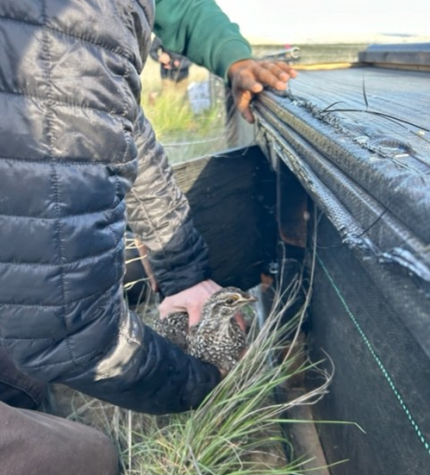
Sharp-tailed Grouse Lek Surveys and Searches: This month wildlife area staff members have continued with sharp-tailed grouse lek surveys. Staff members began completing adjacent lek counts synchronously removing suspicion that birds could be double counted after being flushed. New Natural Resource Technician Garcia started this month and was able to tag along for the last week of lek counts.
Northern Leopard Frogs (NLF): In recent weeks, Biologists Dougherty and Clements, along with the assistance of Technicians Leipold, Kelly, Reed and Puckett, successfully established 25 tadpole pen enclosures at Columbia National Wildlife Refuge where eggs collected directly from Potholes Reservoir are being reared along with tadpoles that have been reared at our partner locations, the Oregon Zoo and Northwest Trek. The crew has also completed the elastomer tagging to help identify metamorphs later in the summer field season.
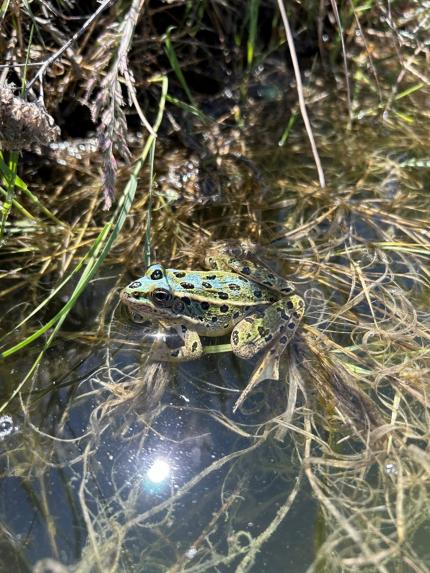
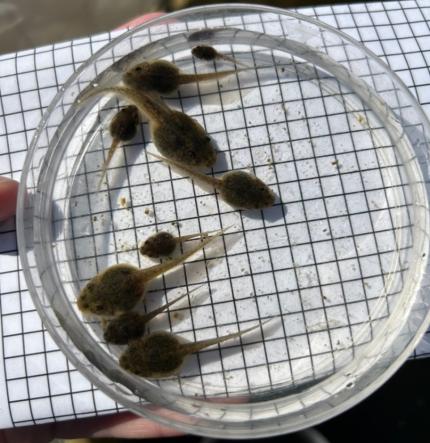
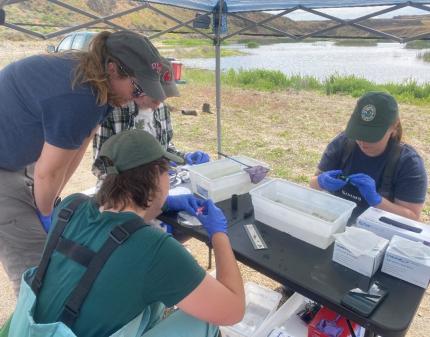
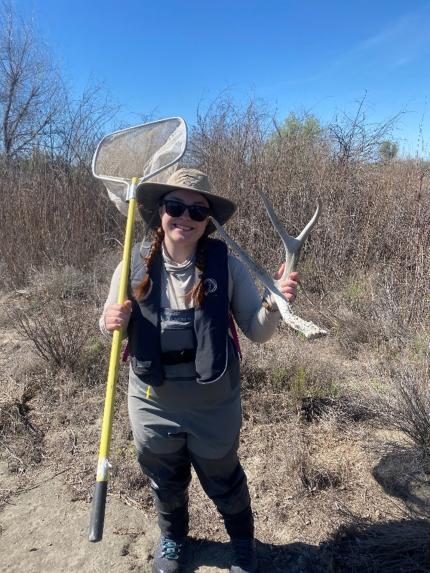
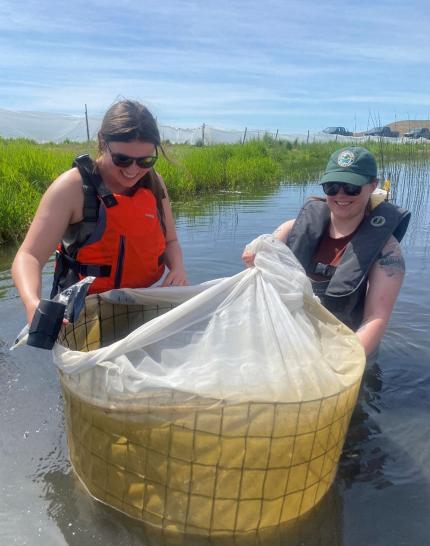
Waterfowl: Biologists Dougherty and Clements, with the help of volunteers from a local waterfowl group chapter, have been monitoring hen mallard nest tubes that got reconstructed over the winter and were placed in early spring. So far one nest tube has been seen to have a hen mallard inside of it while a couple of others have shown some early activity of nesting inside of them. The monitoring will continue throughout the month of June.
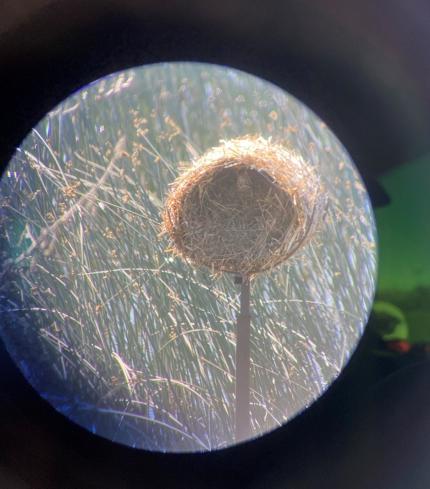
Sage Grouse Surveys: Private Lands Biologist Braaten continues to count and search the last of the grouse leks in Douglas County for 2024. This last two weeks Private Lands Biologist Braaten has walked many miles of Conservation Reserve Project (CRP) in north Douglas County. These efforts finally paid off with the discovery of two new sharp-tailed grouse leks consisting of an additional 15 grouse.
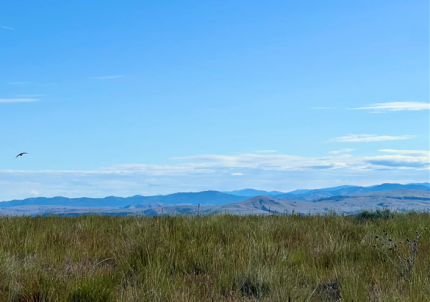
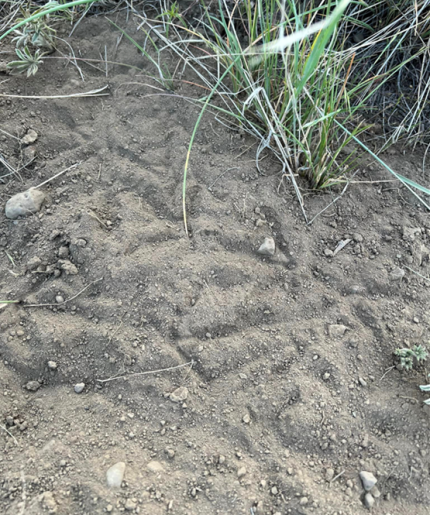
Pygmy Rabbit Support: Biologist Cook and Technician Blanchard mowed a fire lane to provide access and an area for fire crews to create a defensible space in case of wildfires. The main goal of this work is to protect one of the pygmy rabbit enclosures. On the same trip, Cook and Blanchard mowed access roads used by the pygmy rabbit crew to reduce fire risk when it will most likely be accessed later in the year when fire danger is higher. During the mowing Cook drove the tractor while Blanchard followed in a truck with a 110-gallon spray tank to be able to extinguish any fire starts that may occur. The mowing also occurred in the morning on a day with lower winds and temperatures to reduce fire risk.
Providing Recreation Opportunities
Hunter Access: Biologist Morris checked and posted signs on hunter access properties.
Providing Recreation Opportunities
Hunter Access: Biologist Morris checked and posted signs on hunter access properties. Morris maintains signs on several thousand acres, so working on them throughout the summer ensures all properties will be properly posted come hunting season this fall.
Providing Conflict Prevention and Education
Livestock Depredation Claim Processing: Specialist Heilhecker provided information on a nonlethal deterrence checklist for a producer who filed a livestock depredation claim.
Wolf Non-Lethal Deterrence Outreach: Specialist Heilhecker worked with Communication Specialist Lehman and Wildlife Regional Program Manager Haug to update a nonlethal deterrence measure blog to be used on Washington State Department of Fish and Wildlife social media. The blog will go out this spring to remind producers of mitigation tools to minimize livestock-wolf interactions. The blog will also remind everyone that U.S. Fish and Wildlife Service manages wolves east of Highway 97.
Providing Information: Specialist Heilhecker provided comments to the Methow Valley Bear Assessment compiled by Home Range Wildlife Research. Home Range was contracted by Defenders of Wildlife to write the assessment. The assessment used Washington Department of Fish and Wildlife data to look for areas in Twisp, Winthrop, and Mazama that had repeated bear interactions due to unnatural attractants. Specialist Heilhecker provided clarifying comments to correct some information stated in the assessment.
Habitat Plots: Biologists Morris and Cook along with Technician Blanchard, planted several hundred trees and shrubs. These replants and additional plants were done in a previously planted plot that will provide cover and forage for upland game birds, deer, and non-game animals such as rodents, songbirds, and pollinators. Biologist Morris also sprayed weeds in the plot to reduce competition to the desirable native species and hopefully improve survival.
Supplemental Food Plots Preparation: Biologist Cook mowed three supplemental food plots, totaling 3.5 acres, to prep for herbicide application and seeding next month. Two of the three plots have permanent buried irrigation line and the third will be installed this spring. Puget Sound Chapter of Pheasants Forever is completing this installation as part of their habitat improvement efforts with this landowner. Irrigation is also done by a chapter member for the length of the season. Biologist Cook also helped transport the irrigation pipe for the new system to the site.
Conservation Reserve Program: Biologist Morris worked on more recommended leave areas for the Conservation Reserve Program to protect potential pygmy rabbit habitat. Part of the reason for preserving sagebrush areas is that it can take 10-20 years to get a stand of sagebrush that is mature and dense enough to support pygmy rabbits. Every time mature sagebrush is destroyed it resets the clock for another 10-20 years before the area could provide pygmy rabbit habitat again.
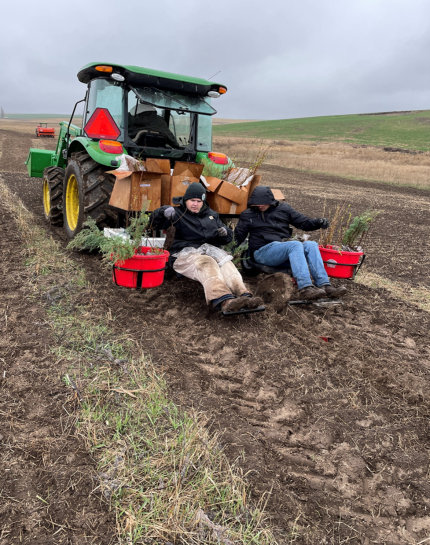
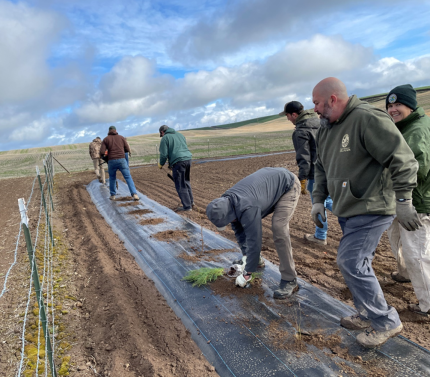
Providing Conflict Prevention and Education
Elk Issues: Specialist Heilhecker received a report of elk damage. The livestock producer stated 60 head of elk were eating all the grass. Therefore, he was not able to turn his cows out to pasture. The elk are also damaging his livestock fences. They discussed nonlethal hazing options. Specialist Heilhecker will meet with the producer to sign a damage prevention cooperative agreement.
Range Rider Coordination: Specialist Heilhecker met with a new Washington Department of Fish and Wildlife contracted range rider (CRR). They discussed wolf activity in the county, reviewed paperwork the CRR needs to submit for payment, and possible riding locations for the grazing season. Heilhecker also gave the CRR a Garmin InReach to use. The CRR started work in the Sullivan Creek pack territory.
Depredation Investigation: Specialist Heilhecker and law enforcement investigated a dead calf in the Sullivan Creek pack territory. Based on information gathered at the scene, they determined the calf was a probable wolf depredation event. U.S. Fish and Wildlife Service was notified of the event.
Conserving Natural Landscapes
Limebelt Forest Health: Scotch Creek staff members teamed up with the Sinlahekin staff members for a day of thinning on the Limebelt. In total, approximately ten acres were thinned.
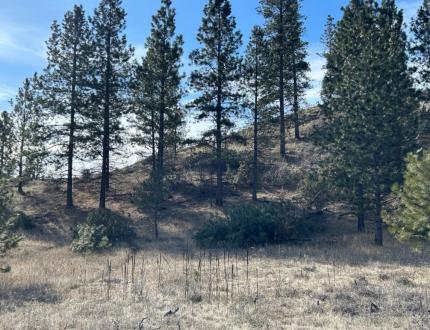
Scotch Creek Riparian Restoration: Staff members constructed a new fence enclosure and added weave material to multiple beaver dam analogs within the project area. The enclosure will be planted with deciduous shrubs the first part of April.
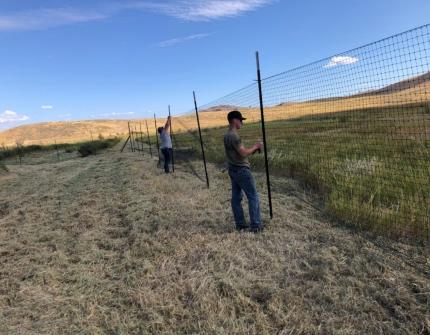
Golden Doe Prescribed Burn: To aid in shrubsteppe restoration efforts, the Methow Wildlife Area conducted a prescribed fire operation in the Golden Doe Unit. Approximately 80 acres of predominantly invasive grasslands were burned, including several small aspen stands. By burning the non-native grasses and weeds, staff members can now treat the area more effectively with herbicide prior to planting native bunchgrasses this fall.
The aspen stands had been void of fire for many years, so it’s anticipated the area will experience strong regenerative growth after the fire. This will provide much needed forage and cover for a wide array of wildlife. Restoration efforts will continue in this area for years to come.
A special thanks to our Prescribed Fire Program for pulling this project together and providing staff members, equipment, and the necessary expertise to have a successful burn. Also, a big thanks goes out to all the wildlife area staff members who stepped up from around the region to help make this burn possible. Without the help of the other wildlife areas, this project would not have happened. The real rockstars of this project are Biologist Eidson (Columbia Basin Wildlife Area), Biologist Pavelchek (Wells Wildlife Area), Natural Resource Technician Zabreznik (Chelan Wildlife Area), Biologist Riley (Sinlahekin Wildlife Area), Natural Resource Technician White (Sinlahekin Wildlife Area), Natural Resource Technician Rise (Scotch Creek Wildlife Area), and Biologist Stanley (Scotch Creek Wildlife Area).
Additionally, we had a special guest assist on the burn, M. Danielson from Conservation Northwest. Danielson hopes to work with Washington Department of Fish and Wildlife to conduct some educational outreach with our partners about the benefits of prescribed burning. Last but not least, hats off to Methow Wildlife Area staff members, Biologist Repp and Natural Resource Specialist Wottlin for planning, prepping, and helping implement this important project.
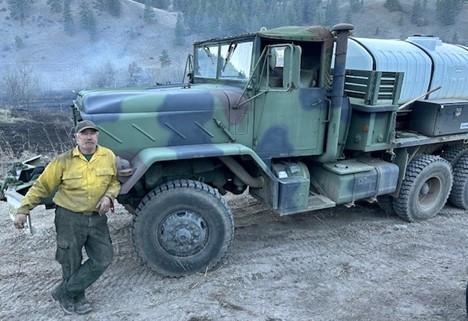
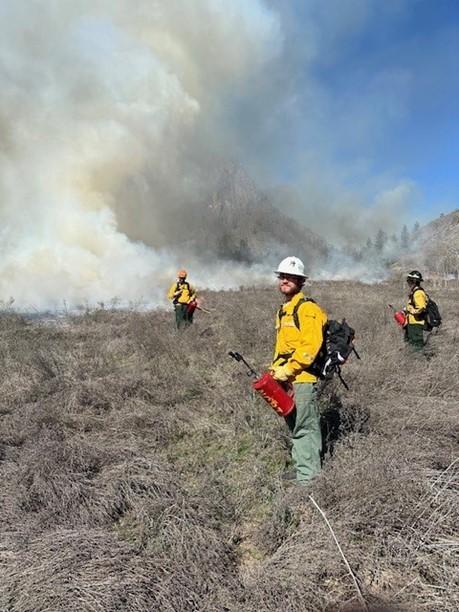
Conserving Natural Landscapes
Bridgeport Bar Irrigation and Preparation: Staff members have been working to prepare fields and irrigation on the Bridgeport Bar for spring seeding. Natural Resource Technicians Haney-Williamson and Ruiz completed routine maintenance, replaced several butterfly valves, and started the pump on the winter wheat fields.
Scotch Thistle Spraying: Wildlife area staff members sprayed Scotch thistle sites across the Big Bend Wildlife Area. They saw a noticeable reduction in the number of plants as a result of last year’s spraying efforts. While completing this project, they assessed the success of last year’s bull thistle spraying and noticed that lakes that were covered in hundreds of bull thistle rosettes last year now host only a handful.
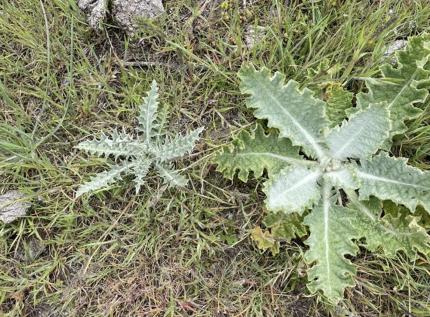
Natural Resource Conservation Service (NRCS) Environmental Quality Incentives Program (EQIP) Spraying: Thirty-nine acres were treated using chemical fallow treatment to prepare for a seeding project on Barry Field in the Big Bend Wildlife Area. In this cooperative project wildlife area staff members supported the grazing permittee and NRCS with this spray project.
Habitat Plots: Biologist Cook met with the Cultural Resources archeologist to look over maps of four potential projects to determine siting changes to avoid known cultural resources and potential needs for field surveys. Cook learned more about the cultural resources review process and how best to submit and track projects review progress. These projects are expected to begin work later this fall or next spring.
Biologist Morris set up a game camera on a habitat plot. The game camera serves two purposes: it will hopefully reveal any wildlife use of the habitat plot, and it will also show the plant development and growth throughout the year.
Biologist Morris has also been monitoring another habitat plot that has some mature and some recently planted (1 year ago) trees and shrubs. The plot has some Canada thistle and will need to be sprayed. Biologist Morris is keeping an eye on the thistle since it will need to be sprayed either when it starts bolting, or this fall before dormancy sets in.
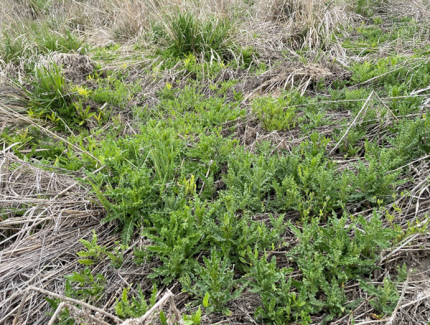
Providing Education and Outreach
Private Lands Work Party: Biologists Morris, Cook, Braaten and Supervisor Rickel attended the Private Lands Work Party in Electric City. The private lands team from across the state met to work on some habitat projects, get training, get updates on the private lands program, and to network with other Private Lands staff members. There was a lot of rain and mud, but it was fun.
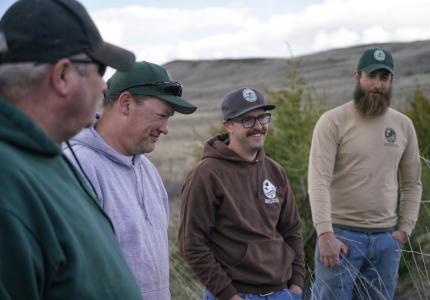
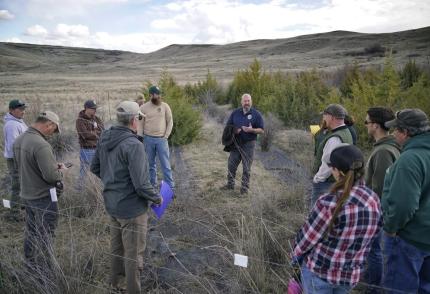
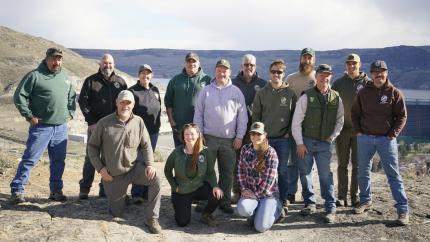
Sinlahekin and Scotch Creek Wildlife Area Advisory Committee: The Sinlahekin and Scotch Creek Wildlife Areas teamed up for their annual Wildlife Area Advisory Committee (WAAC) meeting. It was well attended, including several students from Oroville Schools who participated in the discussion. The Sinlahekin and Scotch Creek staff members provided updates on accomplished work and fielded a variety of questions. A good question and answer session occurred before wrapping up the meeting.
McFarland Middle School Career Day: Biologists Cook and Morris presented to five classes about working as a wildlife biologist at McFarland Middle School’s Career Day. Cook and Morris answered questions about work schedule, pay, and opportunities. They also answered some in depth questions like, what is the coolest animal that you have held or touched? Or what is the best part of your job? Most of the classes gained confidence and asked more questions early and others took a little longer. Cook and Morris told the students that at Washington Department of Fish and Wildlife there are many other staff members besides biologists and scientist, including officers, office staff, and more.
Providing Education and Outreach
Chief Joseph Dam Earth Day Event: Biologists Balderston and Haupt participated in an Earth Day Event at the Chief Joseph Dam where many different organizations led stations for groups of students from local elementary schools. Balderston and Haupt taught students what they can learn about an animal by looking at just their skull.
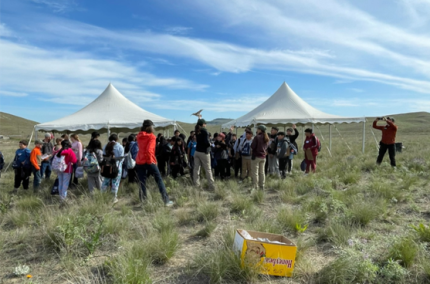
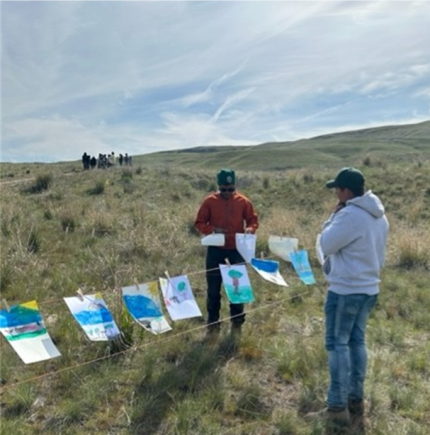
STEAM by the STREAM Event: As hosts of the annual STEAM by the STREAM event, wildlife area staff members prepped the site on the Sagebrush Flat Wildlife Area and led stations for students from local elementary and middle schools. Three of the four stations were run by Douglas County Wildlife Area Complex staff members, and these stations included landscape painting, planting native forbs, and a skull and bones themed nature walk. Students also learned about sharp-tailed grouse and the work that Washington Department of Fish and Wildlife does to help protect and enhance their habitat.
Conducting Business Operations and Policy
Charles and Mary Eder Agriculture Lease: Staff members helped disassemble the wheel lines and roll them to the edge of the field at the Charles and Mary Eder Agriculture Lease property so the field can be tilled and planted by the sharecropper.
Sinlahekin Residence Upgrades: The Sinlahekin residence received a much-needed roof replacement. The project was led by Capital Assets Management Program Construction Project Coordinator Noddings. Contractors removed the old asphalt shingle roof that was missing in some areas and replaced it with a new metal roof. The old roof outlived its life expectancy. The new roof should handle the elements a lot better than the asphalt shingles.
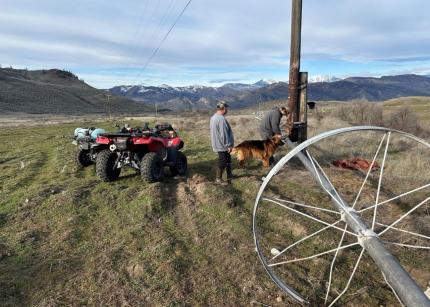
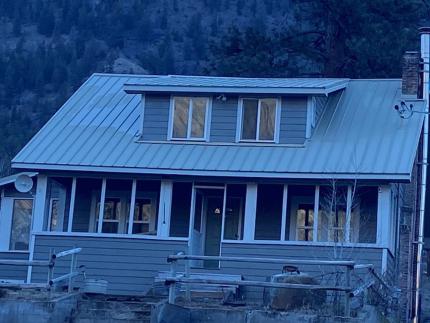
Conducting Business Operations and Policy
Contracting: Lands Operations Manager Finger participated in contractor interviews for a Route Inventory and Assessment contract. The successful contractor will inventory trails, assess trails sustainability, and provide recommendations for trails improvements across a select few wildlife areas across the state.
Safe Harbor Agreements to Conservation Benefit Agreements with U.S. Fish and Wildlife Service: Biologists Rickel and Morris met with U. S. Fish and Wildlife Service staff members to begin transitioning existing Safe Harbor Agreements to Conservation Benefit Agreements. The new regulatory certainty template serves as a better management tool for species conservation and landowner flexibility.
Natural Resources Conservation Service (NRCS) Assistance: Private Lands Biologist Braaten received a call from Okanogan County NRCS. They requested assistance and wanted to talk with someone for advice regarding a 2012 conservation easement Washington Department of Fish and Wildlife has on private land near Oroville. There was a Department of Natural Resources timber thinning project that recommended thinning timber in the easement area. Okanogan Land Trust also forwarded information of easements to Private Lands Braaten regarding this issue. Private Lands Biologist Braaten forwarded info to Regional Program Manager Haug, and he forwarded it to our Real Estate Manager.
Other
Incidental Observations: The recent warm spells have coaxed snakes from their hibernacula. Rattlesnakes are now basking near their den entrances as conditions allow and other species like garter snakes and gopher snakes have begun foraging.
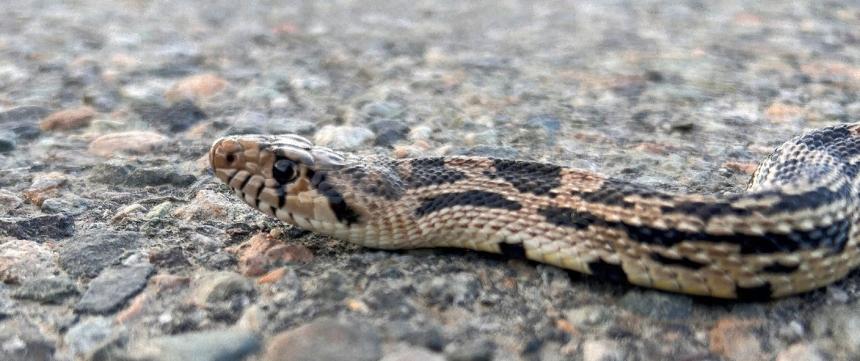
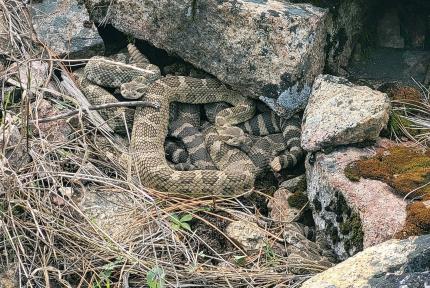
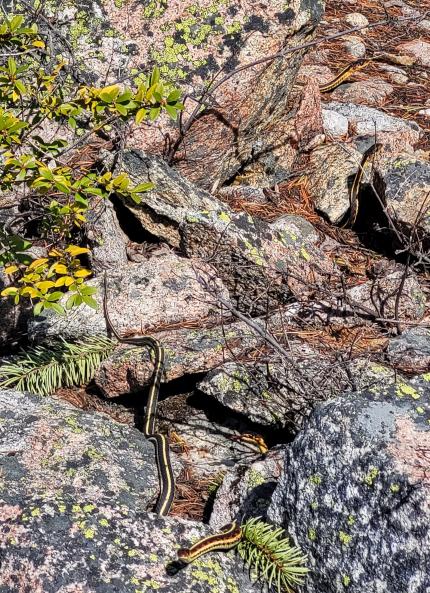
Scotch Creek Boundary Fence Repairs: Staff members repaired approximately two miles of boundary fence on the Scotch Creek Unit, one mile on the Ellemeham Unit, and one mile on the Tunk Unit.
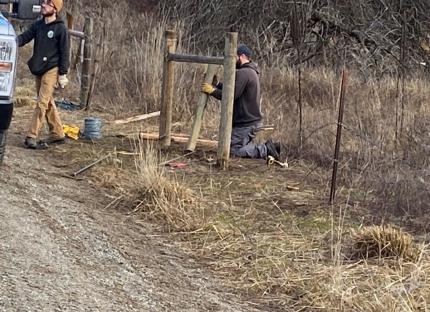
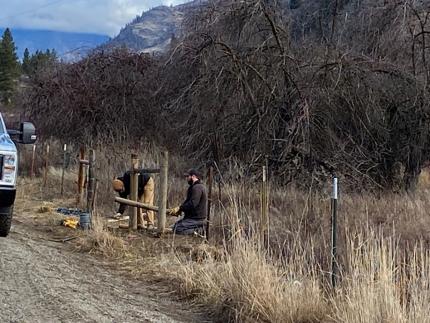
Sinlahekin Fence Repair: Assistant Manager Riley and Natural Resource Specialist White have been using the nice weather to inspect and repair boundary fences on the Sinlahekin Wildlife Area. They have been repairing winter damaged fence and repairing areas that have been neglected for some time. They will be continuing this effort throughout the year.
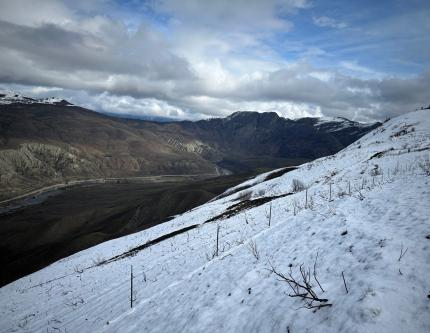
Training: Staff members attended the Lands Division Quarterly and the Okanogan Noxious Weed Board winter recertification class for pesticide credits.
Other
Recreation and Conservation Office (RCO) Grant Applications: Biologists Blake and Haupt submitted RCO grants this month. One application was for work at the Big Bend Wildlife Area, and the other was for the new acquisition at Barclay Crane (Wells Wildlife Area) to do habitat restoration and cultural resource protection.
U.S. Fish and Wildlife Service (USFWS) Sage BIL Grant Application: Biologist Haupt submitted a proposal for a USFWS Sage BIL grant. If funded, the project will involve mowing, weed control, and native planting to improve habitat for Columbia Basin pygmy rabbits on the Sagebrush Flat Wildlife Area.
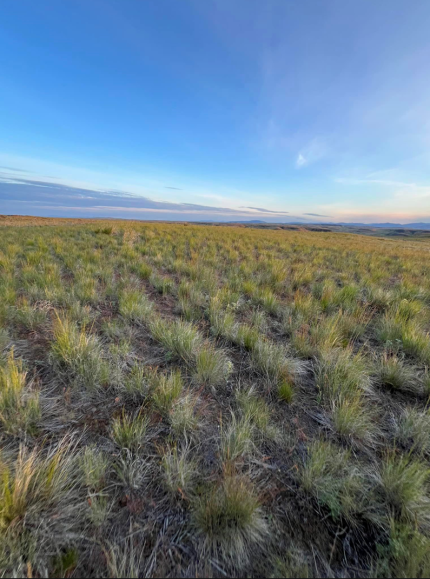
Managing Wildlife Populations
Region 3 Elk Surveys: Region 3 District Wildlife Biologists Wampole and Fidorra conducted aerial surveys of the Colockum elk herd. Aerial surveys provide data to estimate population size and post-hunt calf to cow and bull to cow ratios. This information is used to inform population trends.
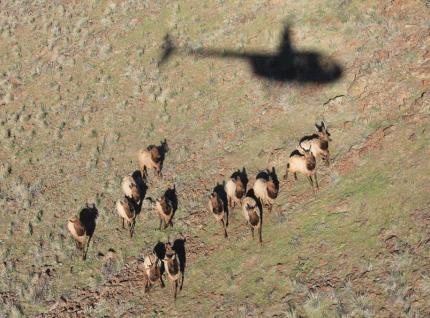
Oak Creek Wildlife Area Elk Feeding Operations: Oak Creek staff members wrapped up the last of elk feeding on the Oak Creek Unit on March 16 and on the Cowiche Unit on March 19. A total of 702.9 tons of hay were fed to wintering elk from Dec. 26, 2023 to March 19, 2024. The high count of elk fed during this season was 3,072.
Walleye Fishing for Predator Food Web Project: L.T Murray Wildlife Area Assistant Manager Winegeart and Natural Resource Technician Blore assisted the Large Lakes fisheries team by taking a day to help catch walleye near Lyons Ferry. The study is to evaluate and understand prey utilization by walleye, but the L.T. Murray crew focused on fishing and learning more about what their coworkers do on a daily basis.
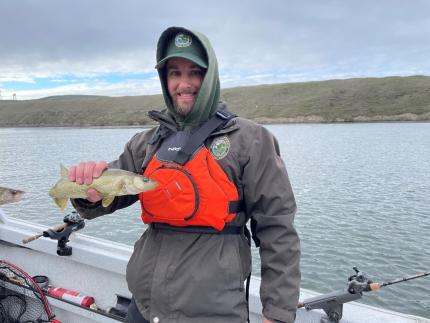
Providing Recreation Opportunities
L.T. Murray Recreation Access: After receiving a complaint from a hiker, L.T. Murray Wildlife Manager Morrison and Assistant Manager Winegeart looked at a structure that was constructed by a private landowner years ago on the Quilomene Unit property boundary. The structure was built to eliminate corner hopping from Department of Fish and Wildlife to Department of Natural Resources land.
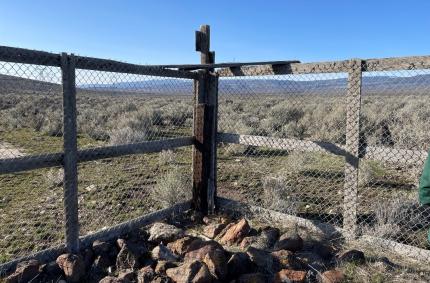
Conserving Natural Landscapes
L.T. Murray Wildlife Area Access Site Improvements: L.T. Murray Wildlife Area Assistant Manager Winegeart, Natural Resource Scientist Nass, and Natural Resource Technician Blore replaced a partially burned wire gate with a new metal gate and placed barrier rock around the perimeter of the Whiskey Dick Unit’s Pump House Road parking site to replace the sagebrush barrier that was lost to the 2022 Vantage Highway fire. Individuals with trailers had begun driving outside of the parking site around other vehicles to turn around to avoid having to back up. A few tested their vehicles 4-wheel drive capabilities by driving farther into the newly replanted shrubsteppe. The rocks and gate provide an obvious boundary and facelift for this site.
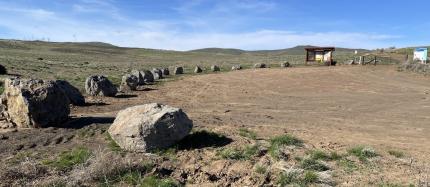
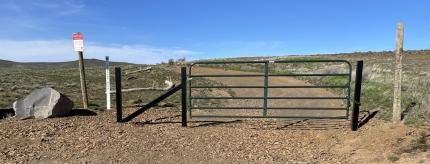
Wenas Wildlife Area Plug Planting: Wenas Wildlife Area staff members, along with help from Region 3 Natural Resource Specialist Boggs, planted plugs of various species in three locations across the wildlife area. Near Sheep Co. Road, both sage and bitterbrush were planted, while a variety of species including sage, juniper, mock orange, bitterbrush, and Scouler’s willow were planted throughout the Cow Canyon fire 2022 burn scar and the Evans Canyon fire 2020 burn scar on Cleman Mountain.
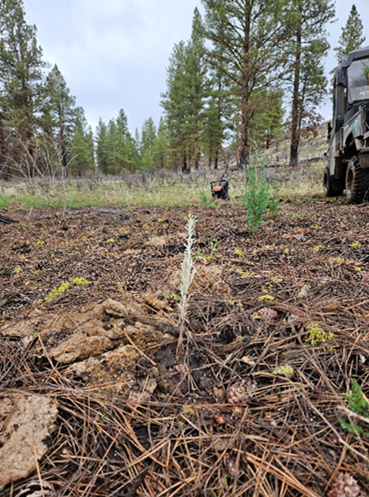
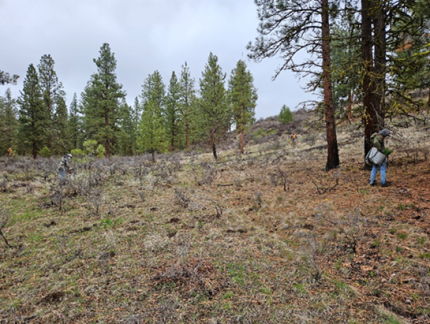
Wenas Wildlife Area Fence Repair: Wenas Wildlife Area Natural Resource Technicians Stoltenow and Janes repaired a portion of fence surrounding a parking area off Durr Road that had been torn down and members of the public were driving through off the green dot road. Tracks were going through a Conservation Reserve Program lease where the agency is working with a lessee on reestablishing the site back into native habitat.
Wenas Wildlife Area Firebreak Maintenance: Wenas Wildlife Area staff members finished burning weeds throughout the firebreak that runs along the elk fence in the southern portion of the wildlife area. The removal of the tumbleweeds will improve the chances of wildfires in the wildlife area to be contained and not jump to neighboring properties. This will also improve the effectiveness of the herbicide that will be applied to the firebreak. The herbicide will prevent weeds from building up throughout the rest of the year.
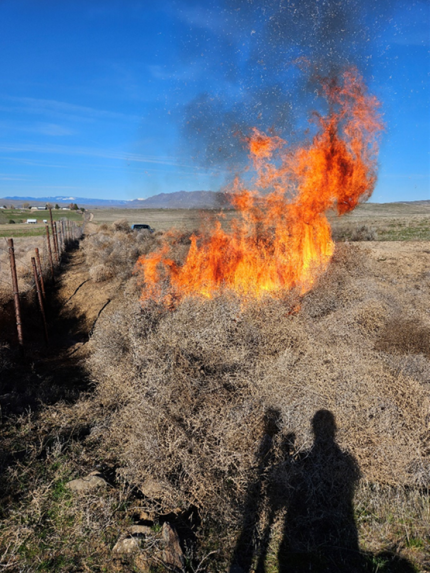
L.T. Murray Wildlife Area Grazing: Manager Morrison worked with a Vence technician to install a virtual fence base station (tower) on the Quilomene Unit of the L.T. Murray Wildlife Area. The tower has a line-of-sight reach of approximately ten miles. The wildlife area’s cattle grazing lessee will place GPS enabled shock collars on all adult cows that will communicate with the base station to allow the grazer to alter the collar’s preloaded boundaries via radio frequency while the GPS function will allow for tracking and delivering audible sounds and incremental shocks to the cows when necessary.
The 2024 grazing season will mark the beginning of virtual fence use on the wildlife area. Hopes are high for this grazing management technique to be successful due to the state of the areas pasture fences and the impediment of fences to the wildlife that utilize the wildlife area. Boundary fences and fences needed for safety, such as fences paralleling the highway, will still be maintained. Ideally, internal pasture fences that are in very poor condition will be removed several years from now once the program proves successful.
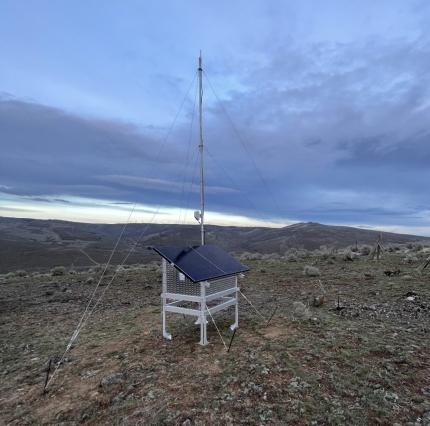
Sunnyside-Snake River Wildlife Area Byron Shrub Planting: Sunnyside-Snake River Wildlife Area Manager Kaelber, Assistant Manager Ferguson, Natural Resource Technician Cardenas, along with help from Region 3 Private Lands Biologist Manderbach have been plugging away with shrub plantings on the Byron Unit. These shrubs are part of a fire restoration project after a fire burned much of the area in September 2022. Sagebrush, bitterbrush, juniper, mock orange, serviceberry, golden currant, and Pacific willow are all being planted.
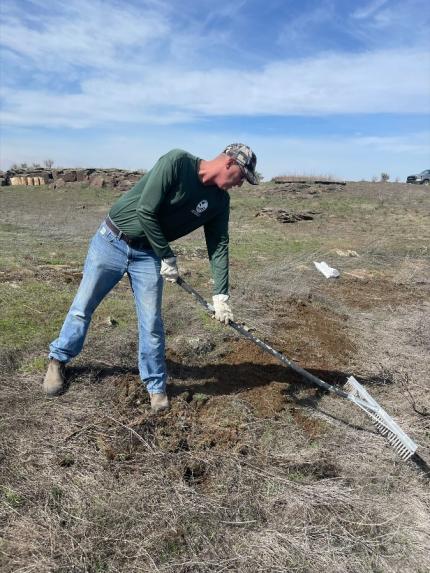
Pine City Planting: Region 3 Private Lands Biologist Manderbach assisted Region 1 Private Lands Biologist Nizer and a group of volunteers with a large shrub and tree planting project in Pine City. The area burned in the Labor Day fires in 2020 and is an important roosting area for turkeys. Ponderosa pines were planted on the hillsides, along with hawthorn, juniper, and Wood’s rose in the flats. Nearly 700 plants were put in the ground that day on top of the 800 that were planted earlier in the week.
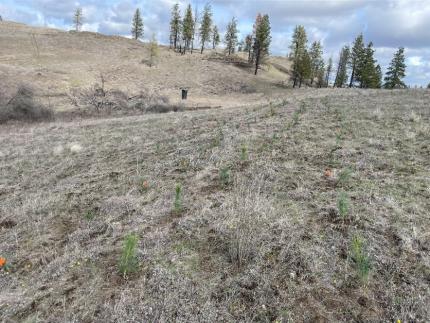
Providing Education and Outreach
Oak Creek Wildlife Area Kiosk Updates: Oak Creek Wildlife Area Natural Resource Worker O’Brien updated signage at the kiosks on Tim’s Pond and the Naches River access site across from Rowe Farms.

Other
Oak Creek Wildlife Area Graffiti Removal: Natural Resource Worker O’Brien covered up graffiti at multiple locations on the Oak Creek Wildlife Area.
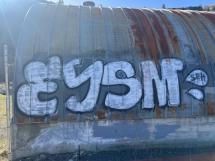

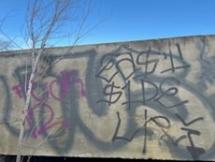
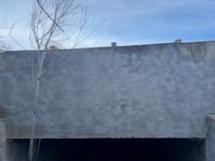
Oak Creek Wildlife Area Gate Improvement: Oak Creek Wildlife Area Manager Mackey and Natural Resource Worker O’Brien retrofitted the locking mechanism of the Mud Lake gate to allow for multiple locks.
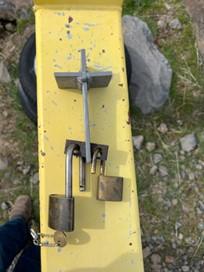
L.T. Murray Wildlife Area Elk Feeding: The L.T. Murray crew members took some bad hay to a local landscaping company for compost. The hay had too much moisture to cover with tarp at delivery and never had a chance to dry so a few of the top bales were set aside during the feeding season. Some would fall through the hay forks like butter.
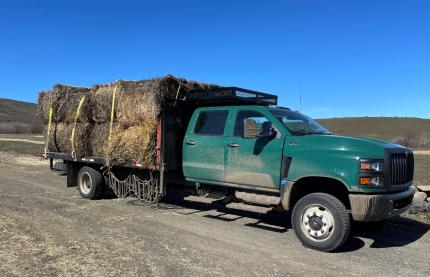
L.T. Murray Wildlife Area Road Management: L.T. Murray Wildlife Area Manager Morrison and Assistant Manager Winegeart inspected an area of the Corrals Access Road on the L.T. Murray’s Whiskey Dick Unit after heavy erosion was reported. The site burned in the 2022 Vantage Highway fire. Without standing vegetation and a litter layer to reduce and slow water runoff and with the addition of potentially hydrophobic soils resulting from fire intensity, excess water runoff altered this once easily traversable road to a barely accessible road.
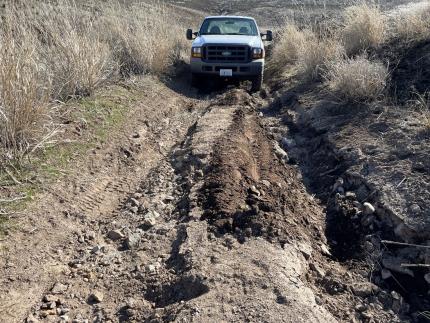
L.T. Murray Wildlife Area Fence Repair: L.T. Murray Wildlife Area Natural Resource Technician Blore worked with a master hunter to repair boundary fence around the Teanaway Valley Unit. Melting snow and wildlife always leave this fence in need of maintenance in the spring.
L.T. Murray Wildlife Area Habitat Work: L.T. Murray Wildlife Area Manager Morrison and Habitat Biologist Reavill deployed 20 data loggers in meadows near the L.T. Murray Unit’s Tamarack Spring to monitor snow melt timing and water availability to start a project to improve headwater retention in the Manastash drainage.
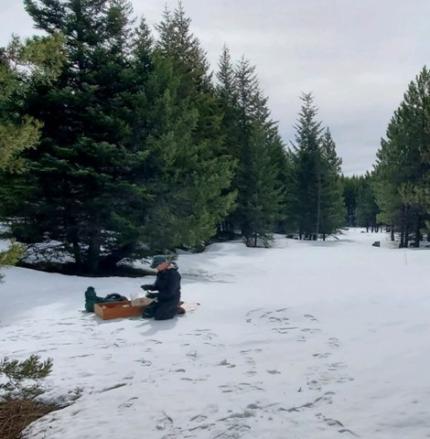
Private Lands Work Party: Most of the Private Lands team members from around the state met in Electric City for an annual Private Lands Work Party. Region 3 Private Lands Biologist Manderbach met many Private Lands staff members he had not met before. Private Lands biologists demonstrated equipment and tractor implements. They planted around 600 shrubs and seeded two food plots.
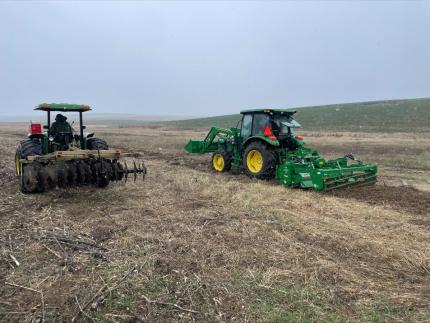
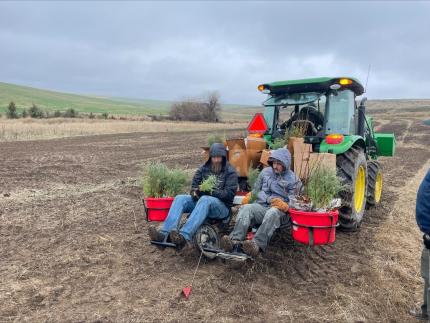
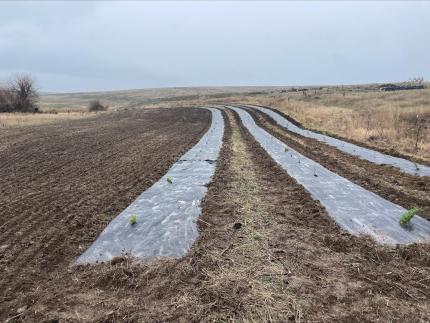
Managing Wildlife Populations
Oregon Spotted Frog Surveys: Biologists Wickhem and Bergh, with the help of Private Lands Biologist Gray, Regional Director Sallee, Species Lead Hallock, Customer Service Specialist Splitgerber, Volunteers Petrick and Roe, and staff members from the Washington Department of Natural Resources and the U.S. Fish and Wildlife Service, surveyed for Oregon spotted frog egg masses in both the Glenwood and Trout Lake valleys during the second half of March.
Oregon spotted frogs are listed as federally threatened and state endangered and have been on the decline in Glenwood and the Trout Lake Valleys in recent years due to drought and predation by bullfrogs. By counting egg masses laid and multiplying by two (to account for the one female and one male responsible for each egg mass), we are able to get a population estimate for each watershed. Though we are still tallying up the final numbers for the 2024 season, the team was grateful to find significantly more egg masses at both locations. Hopefully the trend continues in the coming years!
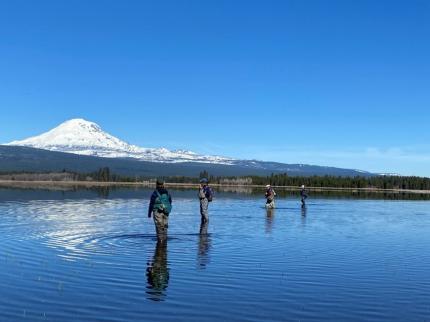
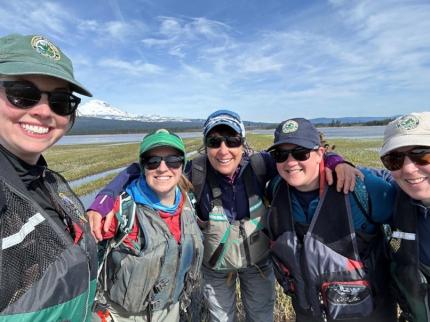
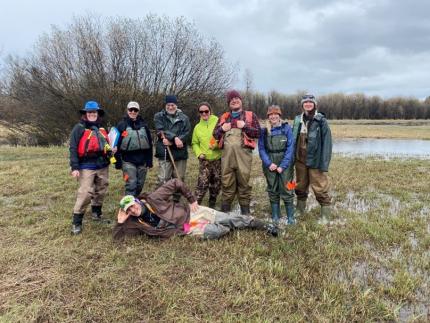
Mt. St. Helens Elk Herd Survey: Biologists Holman, Stephens, Bergh, and Wickhem, Ungulate Specialist Oates, Wildlife Area Assistant Managers Risley and Breitenstein, along with Habitat Biologist Johnson worked together to complete an aerial survey of the Mt. St. Helens elk population. The primary effort took place over the “Core Mt. St. Helens Herd Area” which includes Game Management Units (GMU) 520 (Winston), 522 (Loo-Wit), 524 (Margaret), 550 (Coweeman), and 556 (Toutle). Additionally, areas within Game Management Units 554 (Yale), 560 (Lewis River), 568 (Washougal), and 572 (Siouxon) were surveyed on a more exploratory basis. The survey is conducted by helicopter, while three Washington Department of Fish and Wildlife observers, plus the pilot, search the landscape for elk. The animals are then counted as well as classified by sexes and ages. Additionally, variables including concealing vegetation and location are documented for each group of elk.
A total of 2,368 elk were observed by the team over the course of six days. Following data analysis, estimates of herd population size, core-herd population size, GMU population sizes as well as calf to cow and bull to cow ratios will be generated. These metrics will be used to evaluate the status of the Mt. St. Helens elk population per the guidelines outlined in the Washington Department of Fish and Wildlife Game Management Plan: Washington Department of Fish & Wildlife 2015-2021 Game Management Plan | Washington Department of Fish & Wildlife and the Mt. St Helens Elk Herd Plan: Washington State Elk Herd Plan: Mount St. Helens Elk Herd | Washington Department of Fish & Wildlife and will be reported in the annual Game Status and Trend Report: Publications | Washington Department of Fish & Wildlife
Thanks to the many staff members who participated in the survey. Thanks to Region 5 Customer Service Staff Members Rainwaters, Splitgerber, and Kean as well as Regional Wildlife Program Manager Jonker for their respective roles of weekday and weekend flight following. Thanks to Contract Specialist Luque, Contracts and Purchasing Manager Hugdahl, and Ungulate Section Manager Garrison for their respective roles in lining up the contractual and budgetary aspects of this work. Finally, thanks to Pilot Pete Emerson of JL Aviation for his unmatched skill in piloting during the effort as well as seamless logistics, efficient use of our funding, precise weather forecasting, and for spotting plenty of the elk.
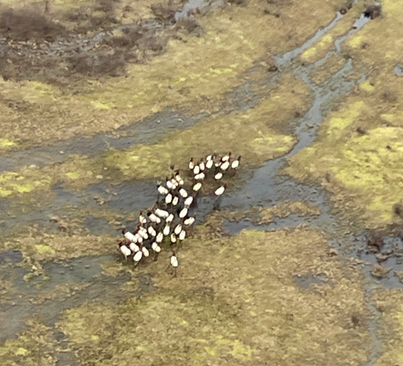
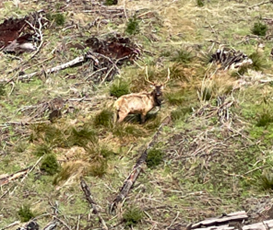
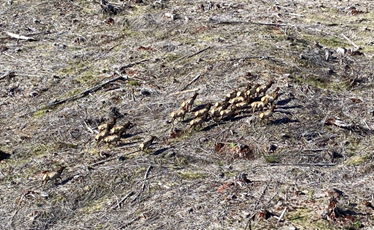
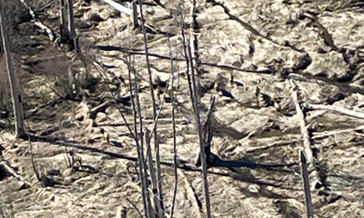
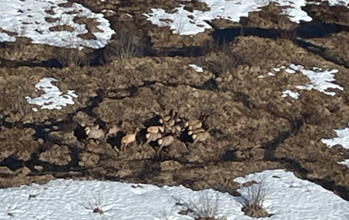
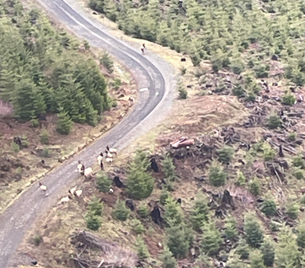
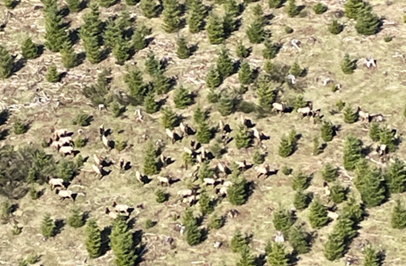
Providing Recreation Opportunities
Art From Unknown Guest: Natural Resource Specialist Celaya found an interesting sight at the entrance of the Mineral Springs (Icehouse) Access Area in Klickitat County.
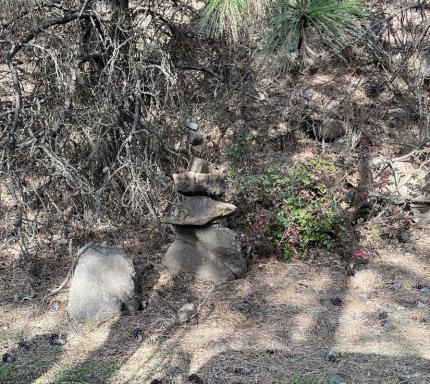
Providing Conflict Prevention and Education
Livestock Carcass Disposal: Wildlife Conflict Specialist Jacobsen removed 2.5 tons of domestic cow carcasses from a livestock operation where a collared wolf in Klickitat County was known to frequent. The utilization of carcass piles and natural decomposition is a practice widely implemented across western states by ranchers to deal with livestock losses on their operations. It is one of only a few legal means of disposing of deceased animals. However, these carcass piles regularly attract scavenging carnivores to livestock operations and can inadvertently lead to livestock-wildlife conflict issues.
Tree Damage: A concerned landowner contacted Wildlife Conflict Specialist Jacobsen regarding damage to the Douglas fir trees on his property. Within the past year, a handful of trees began to die, all with their tops girdled by some animal. The landowner felled one of the damaged trees so that Jacobsen could inspect it. While the teeth marks on the bark appear to be very narrow, the jury is still out as to whether the tree was damaged by western gray squirrels or if porcupines were the primary culprit and western gray squirrel damage was secondary to the porcupine damage.
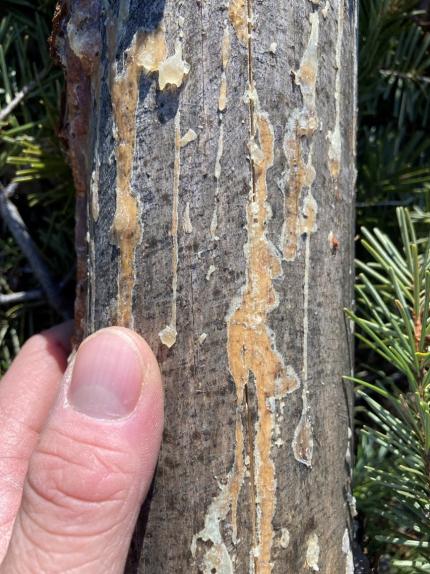
Cooperative Fencing Project Inspections: Wildlife Conflict Specialists Jacobsen and Janowski met with two different landowners who had completed Washington Department of Fish and Wildlife landowner cooperative deer and elk fencing projects. Under these agreements, Washington Department of Fish and Wildlife provided the fencing materials while the landowners were responsible for installation labor and fence maintenance. Both fences looked excellent and both producers were elated at the difference the fences made to their operations, including to their financial savings from past damage, increased production due to damage prevention, and eliminated their staff members’ time hazing costs.
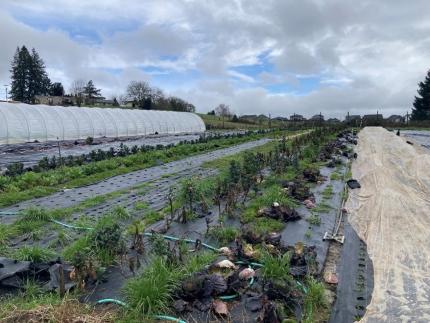
Sick Deer: Wildlife Conflict Specialist Jacobsen responded to a report of a sick deer next to a residence that was no longer able to stand up. Upon inspecting the deer, Jacobsen determined that the deer was in very poor condition and euthanized the deer.
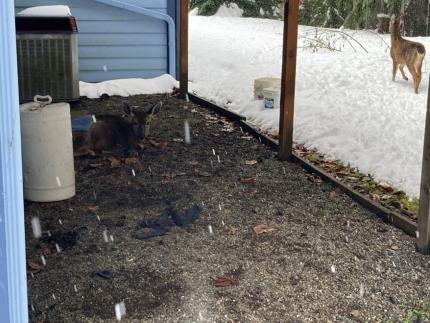
Cougar Near Residence: Wildlife Conflict Specialist Jacobsen responded to a residence where a cougar had been observed the night before and had subsequently been lethally removed by the county. Jacobsen collected tooth and tissue samples from the female cougar. Jacobsen discussed cougar behavior and biology with the landowner and performed a walk-through of her property to review possible future sources of conflict as well as deterrent methods.
The landowner had lost three domestic cats over the past week, and a necropsy of the cougar revealed that the cougar had consumed a domestic house cat. The landowner reported that nine additional domestic house cats were roaming the property. Jacobsen discussed the problem of outdoor house cats and the frequency with which cougars are known to prey on outdoor house cats, as they resemble other natural cougar prey species such as raccoons and porcupines.
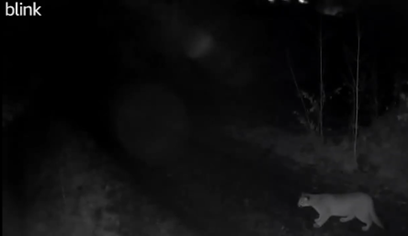
Conserving Natural Landscapes
Prescribed Burning at Shillapoo Wildlife Area: Recently, Washington Department of Fish and Wildlife staff members at Shillapoo Wildlife Area have been utilizing prescribed fire for vegetation management. While fire can be destructive if uncontrolled, it can also be a useful tool for land managers. Prescribed burns reduce fuel levels, help control invasive weed species, and can increase soil health. While weather conditions were favorable, multiple small prescribed fires were used to control invasive blackberry and remove piled woody debris from the Rieger tree planting site.
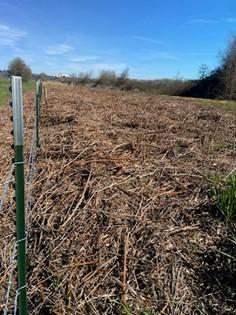
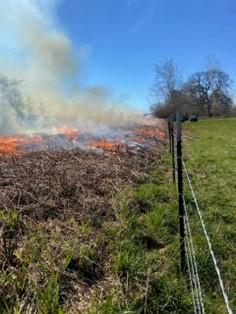
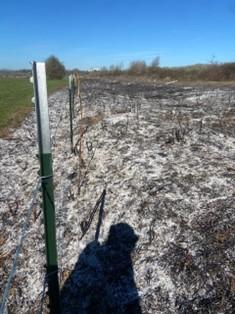
Providing Education and Outreach
White Salmon Tree Fest: Wildlife Conflict Specialist Jacobsen hosted a booth at Underwood Conservation District’s annual White Salmon Tree Fest. Several other agencies and organizations were present, including the Rowena/Mountain Top Wildlife Clinic, Columbia Land Trust, Humble Roots Nursery, Washington Department of Natural Resources, and the U.S. Forest Service. The event was well attended by over 200 citizens.
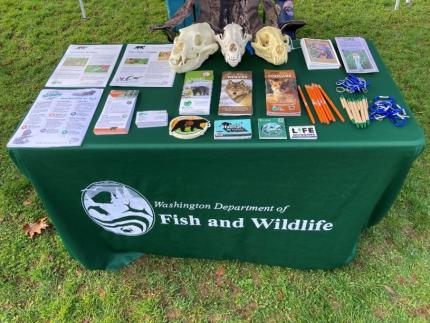
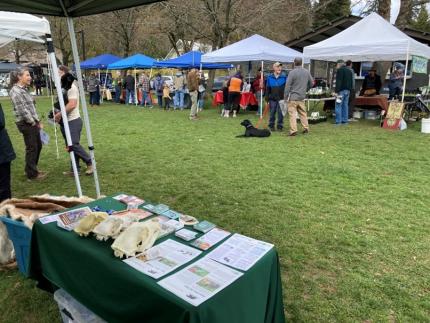
Conducting Business Operations and Policy
Wildlife Capture Scenario Practice: Wildlife Conflict Specialist Jacobsen hosted a training with Washington Department of Fish and Wildlife Detachment 53 to review strategies, techniques, and past and potential scenarios for carnivore and ungulate captures.

Other
New Staff Member: Region 5 is very excited to welcome their new team member, Tessa Ott. Tessa started today in a new position as an Assistant District Wildlife Biologist in District 9 stationed in White Salmon. Tessa has spent the last year as the Assistant District Wildlife Biologist for Oregon’s Department of Fish and Wildlife based out of Portland. Prior to this, she worked various seasonal positions focusing on non-game species for Oregon Department of Fish and Wildlife and Washington Department of Fish and Wildlife while holding private contracts for American bullfrog mitigation throughout the Columbia River Gorge. Tessa is excited to return to Washington and she enjoys horseback riding, reading, backpacking, and the occasional unsuccessful turkey hunt.